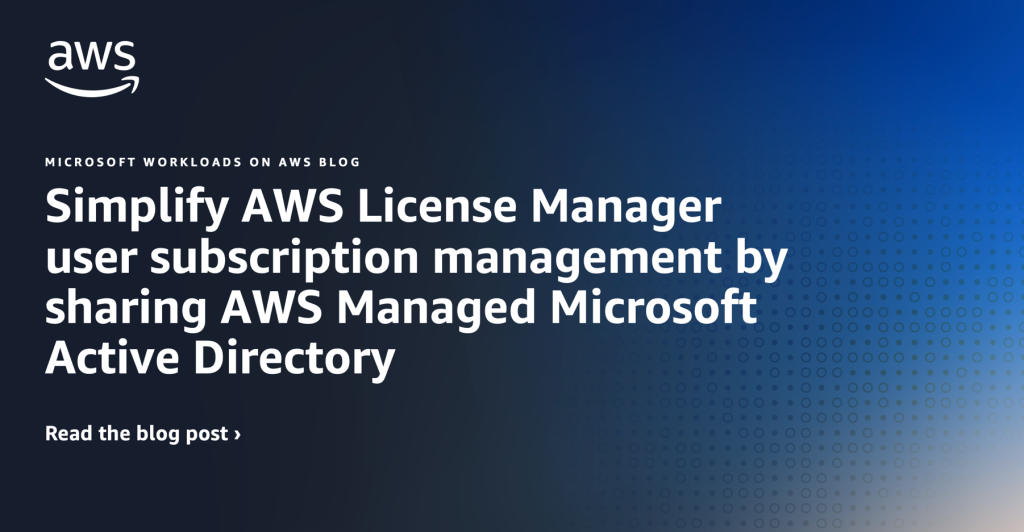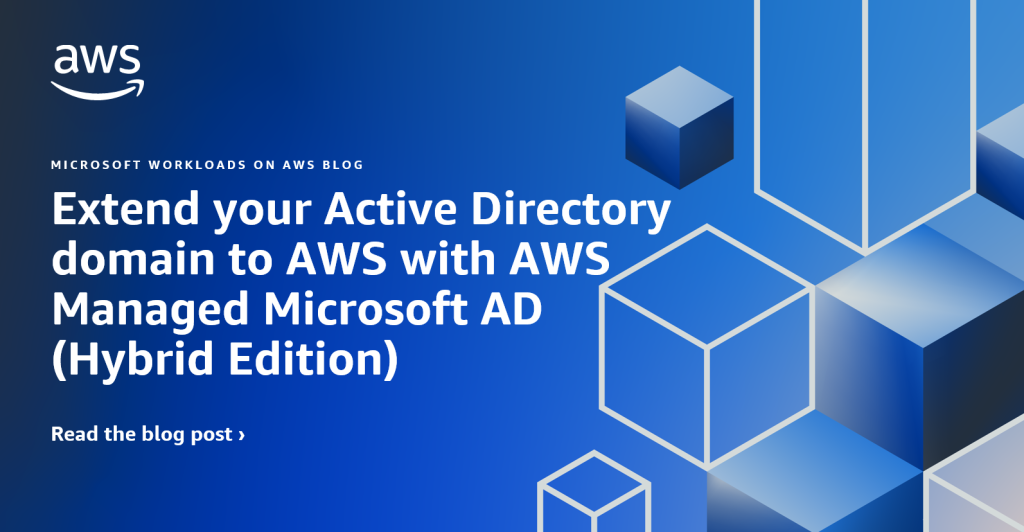Microsoft Workloads on AWS
Category: AWS Directory Service
Simplify AWS License Manager user subscription management by sharing AWS Managed Microsoft Active Directory
In this blog, we’re going to show you how AWS License Manager can leverage the directory sharing feature available from AWS Directory Services for AWS Managed Microsoft Active Directory (AWS Managed Microsoft AD) to centrally manage user subscriptions services while using multiple Amazon Web Services (AWS) accounts. AWS License Manager offers you user-based subscriptions for […]
Extend your Active Directory domain to AWS with AWS Managed Microsoft AD (Hybrid Edition)
Introduction Today, we are announcing the general availability of the Hybrid Edition of AWS Directory Service for Microsoft Active Directory (AWS Managed Microsoft AD). This new edition lets you extend your existing self-managed Active Directory (AD) domain to AWS Managed Microsoft AD while preserving your current identity and access infrastructure. AWS Managed Microsoft AD (Hybrid […]
How to use ACM PCA Connector for AD to enable LDAPS for your Active Directory
September 15, 2025: AWS Private CA Connector for Active Directory now supports server-side LDAPS certificate enrollment for AWS Managed Microsoft AD domain controllers. To learn how to enable server-side LDAPS for your AWS Managed Microsoft AD directory using AWS Private CA Connector for Active Directory, please refer to our updated documentation. In this blog, we […]
Enhance security of your AWS app integration with AWS Managed Microsoft AD
In this blog post, I will show you how you can strengthen security when using two-way trusts between your self-managed Microsoft Active Directory and your AWS Managed Microsoft AD for accessing AWS applications. Introduction Customers often want their self-managed Active Directory users to have a seamless authentication and authorization experience when using Amazon Web Services […]
Streamline Identity Management with AWS Directory Service and One Identity Active Roles
In this blog post we will explore several scenarios where combining AWS Managed Microsoft AD and Active Roles can streamline and accelerate your AWS workload implementations. Many organizations rely on Microsoft Active Directory (AD) to manage identities and access controls, and extending AD infrastructure to the cloud is a common goal. This need often arises […]
Providing self-service multi-account access to AWS Managed Microsoft AD
Introduction In this blog post, I will show you how to selectively share a central AWS Directory Service for Microsoft Active Directory (AWS Managed Microsoft AD) directory across your multi-account environment through a self-service model using AWS Service Catalog. In a large and growing AWS Organizations environment with decentralized teams, you want to remove as […]
Automated user creation and provisioning in Active Directory and Amazon WorkSpaces
For customers that have workloads in the AWS Cloud, a common use case is the provisioning of new user accounts in Active Directory, and subsequently, WorkSpaces for these new users. In this blog post, we will present an efficient and reusable solution to automate the creation, provisioning, and deprovisioning of Microsoft Active Directory (AD) user […]
Optimizing large-scale migration of SQL Server databases to Amazon EC2 using backup metadata
In this blog post, we explore how the Microsoft SQL Server backup metadata, known as backup headers, can be leveraged when migrating from on premises to Amazon Elastic Compute Cloud (Amazon EC2). This technique is particularly useful when access to source database information is non-existent or only backup files are available with no access to […]
How to generate TLS certificates for a highly available Remote Desktop Gateway Farm
Introduction In this blog post, I am going to show you how to generate, import, test, and troubleshoot a properly created Transport Layer Security (TLS) certificate for a Remote Desktop Gateway (RD Gateway) farm. Secure management of your Amazon Elastic Compute Cloud (Amazon EC2) instances for Microsoft Windows Server is a top priority for any […]
Accelerate Amazon EC2 Auto Scaling for Microsoft Windows workloads
In this blog post, we will present a sample solution and provide recommendations on how to reduce both the cost and time associated with a Microsoft Windows Server instance joining an Amazon Elastic Compute Cloud (Amazon EC2) Auto Scaling group up to 78%. Customers using Amazon EC2 Auto Scaling often desire faster scale-out times to […]









